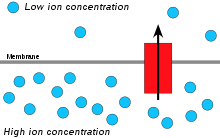UTPA STEM/CBI Courses/Microbiology/Chemiosmosis in Eukaryotes
Course Title: Microbiology
Lecture Topic: Chemiosmosis in eukaryotes
Instructor: Dr. Murad Odeh
Institution:South Texas College. Mcallen.Texas.78504. Office (956)872-2187
Challenge Question[edit | edit source]
If the pH of the solution in which mitochondria are suspended changes from 7.15 to 6.82 during aerobic respiration , what is the resulting pH in the intramembrane space between the outer membrane and cristae of the mitochondria ? The following information is needed to answer the challeneged question:
- The volume of the solution is 5 µl and 5 mg of cytochromes are present within the inner membrane of the mitochondria (cristae).

Backwards Design[edit | edit source]
Course Objectives
- Primary Objectives- By the next class period students will be able to:
- Understand the concept of chemiosomosis
- Biochemical mechanisms of chemiososmosis
- How to calculate changes in the pH values across the mitochondrial membranes
- Sub Objectives- The objectives will require that students be able to:
- Students must be familar with the anatomy of the mitochondrium
- Students must be familar with the physiological pathways carried inside the mitochondium during chemiosomosis
- Students must be able to think logically and analytically using chemical principles in a biological template
- Difficulties- Students may have difficulty:
- The concept Hydrogen translocation and significance
- Mathematical calculation of Hydrogen ions across the inner membrane of the mitochondria
- Real-World Contexts- There are many ways that students can use this material in the real-world, such as:
- Acid/Base balances in human body
- Compensetory mechanisms of hydrogen ions across cellular membranes
Model of Knowledge
- Concept Map
- Begin with glucose which is broken down to 2 molecules of Glyseraldehyde-3-phosphate (G3P) consuming 2 ATP
- G3P is further oxidized to puruvate producing 4 ATP and 2 NADH in the cytoplasm of the cell
- Puruvate can either enter the mitochondria for (aerobic respiration) or remains in the cytoplasm if oxygen is not present (anaerobic respiration)
- puruvate is converted to Acetyl Co-A producing 2NADH which (Acetyl-CoA)enters krebs cycle yielding 2ATP, 6NADH and 2 FADH2
- All NADH molecules and FADH2 are carried to ETS in the inner membrane of the mitochondria yeilding 30 ATPs
- if no oxygen is present in the cell, pyruvate is fermented to alcohol, lactic acid and accompanied by the relase of CO2 and H2 (Fermentation) which takes place in the cytoplasm
- Content Priorities
- Enduring Understanding
- Why there is a need to create a proton gradient to generate ATP
- The molecular mechanisms (structural and functional)changes of ATP synthase?
- Important to Do and Know
- The mathematical equation used in calculating pH values of solutions
- The actual calculation of pH values (mathematical skills of plugging numbers
- Worth Being Familiar with
- structure and function of the cell especially the mitochondria
- aerobic respiration vs anaerobic respiration
- Enduring Understanding
Assessment of Learning
- Formative Assessment
- In Class (groups)
- calculate the pH values of the intermebrane space and the matrix of the mitochondria
- use the ph equation, and relate that to the concentration of the cytocromes and the volume of the solution
- Homework (individual)
- Describe the biochemical changes across the mitochondrial inner membranes
- In Class (groups)
Legacy Cycle[edit | edit source]
OBJECTIVE
By the next class period, students will be able to:
- know how to explain ATP synthesis at the biochemical and molecular level
- know how to calculate the concentartion of hydrogen across mitochondrial membranes
The objectives will require that students be able to:
- understand the mechanism of ATP synthesis
- calculate the changes in the pH values and its significance to ATP synthesis
THE CHALLENGE
If the pH of the solution in which mitochondria are suspended changes from 7.15 to 6.82 during aerobic respiration, what is the resulting pH in the intramembrane space between the outer membrane and cristae of the mitochondria? The following information is needed to answer the challeneged question:
- The volume of the solution is 5 µl and 5 mg of cytochromes is present within the inner membrane of the mitochondria (cristae).
GENERATE IDEAS
- Information about the volume of the solution the mitochondria are suspended in.
- Look at other cellular organelles such as chloroplasts and draw a connection between aerobic respiration and photosynthesis
MULTIPLE PERSPECTIVES
- Structural analogies between chloroplasts and mitochondria
- Functional analogies between chloroplasts and mitochondria
RESEARCH & REVISE
plug in the actual pH values based on the concentration of cytochromes in the inner mebrane of the mitochondria and the volume that these electron carries are suspended in
TEST YOUR METTLE
Perform an experiment illustrating the changes in the osmolarity and pH values across mitochondrial membranes and calculate the changes in the concentration of hydrogen cations during ATP synthesis.
GO PUBLIC
In class discussion.
Pre-Lesson Quiz[edit | edit source]
- Draw a mitochondrion and label all it's parts?
- Explain the chemiosmotic theory?
- What is meant by proton motive force?
- Which mitochondria structure is responsible for the synthesis of ATP?
- What is oxidative phosphorylation?
- What is the name of the major enzyme responsible for ATP production?
- What is the molecular structure of ATP synthase?
Test Your Mettle Quiz[edit | edit source]
- What are the molecular substructures of mitochondria?.
- Identify the Location each of the major groups of enzymes involved in citric acid cycle (Kreb’s Cycle),electron transport chain, ATP synthase and proton pumps.
- Describe the significance of the above mentioned enzymes in Q2
- Explain the significance of an abnormal increase in number of mitochondria and/or cristae in cells that have defective mitochondrial proteins.
- Do mitochondria replicate? if yes, how does this process accomplished?
- What is the function of mitochondrial DNA?
- What is the difference between mitochondrial inheritance from Mendelian inheritance?
- How does a cell destroy old mitochondria?
- How are mitochondria involved in apoptosis?